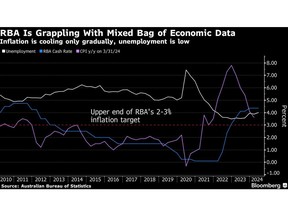Article content
(Bloomberg) — Australian retail sales rose by more than expected in May with spending largely driven by discounts in the face of elevated borrowing costs, an outcome that further strengthens the case for an interest rate hike this year.
Sales advanced 0.6% from the prior month, making it the biggest increase in four months, official figures showed on Wednesday. The outcome, which was double the pace that analysts forecast, follows a 0.1% gain in April.
Article content
In response, yields on policy-sensitive three-year bonds rose as much as 4 basis points to 4.17% as rates traders boosted the odds for an interest rate hike this year. Stocks pared gains.
Sales were driven “by watchful shoppers taking advantage of early end-of-financial year promotions and sales events,” said Robert Ewing, head of business statistics at ABS. “Many retailers started end-of-financial year sales early, offering larger discounts than usual and noted that shoppers remain price-sensitive in response to persistent cost-of-living pressures.”
Retail sales can be an important consideration in policy decisions given consumption accounts for more than half of gross domestic product. The Reserve Bank of Australia has repeatedly highlighted that the outlook for household spending remains a key uncertainty following its 13 rate hikes between May 2022 and November 2023.
Indeed, Wednesday’s data showed retail sales rose just 1.7% from a year earlier, running well below the 4%-5% pace seen in early 2023.
The underlying weakness is a key reason why many economists are circumspect about reading too much into today’s surprise. Callam Pickering, previously an RBA economist and currently APAC analyst for job site Indeed Inc., pointed out that May’s increase followed two consecutive months of tepid results.
Article content
“That sets the scene for another weak June quarter outcome once we account for inflation,” he said. “Quite simply, this remains one of the weakest retail markets we have seen in Australia for generations.”
National Australia Bank’s Tapas Strickland said the data does add to rate hike probabilities for August, though “it is still unclear given the hints at discounting mentioned by the Statistician whether the pickup will be sustained.”
Even so, there is relief on the horizon for Australians, with tax cuts and energy rebates having kicked in this week.
“Consumer spending could rise in earnest from this quarter, given that tax cuts will provide a shot in the arm to households’ real incomes,” said Abhijit Surya of Capital Economics. “However, we suspect that households will choose to bank most of their tax cuts.”
The RBA next meets on Aug. 5-6, with some economists predicting the central bank may tighten policy further to take the benchmark rate to 4.6% — a level not seen since October 2011. The board has placed a high bar to raising rates again, while saying that further tightening cannot be ruled out.
Article content
The consensus among economists so far is still that the RBA will hold rates at 4.35% this year, though some believe a hike in August cannot be ruled out if second-quarter inflation report due July 31 surprises on the upside.
Figures last week showed a partial gauge of consumer prices rose by more than expected for a third straight month in May, prompting money markets to price in odds of a rate hike this year. At the same time, the labor market remains tight, with unemployment hovering around 4%.
Minutes of the RBA’s June meeting released on Tuesday showed a rate hike remains in play, with the policy-setting board emphasizing on the need to remain “vigilant” to upside price risks.
Wednesday’s retail data also showed:
- Turnover in most non-food related industries rose in May
- Clothing, footwear, and personal accessory retailing had the largest rise followed by household goods retailing
- Department stores fell as did eating out and takeaways
—With assistance from Shinjini Datta.
(Updates with economists comments from the seventh paragraph.)
Share this article in your social network

